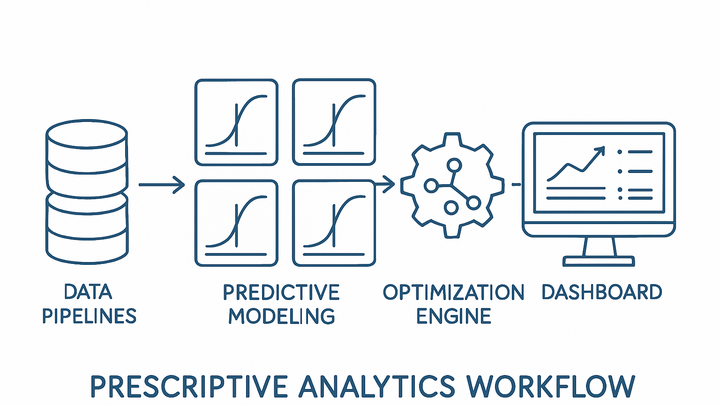Published on 2025-06-27T22:04:41Z
What is Prescriptive Analytics?
Prescriptive analytics is the most advanced analytical discipline, going beyond describing past events (descriptive analytics) and forecasting future trends (predictive analytics). It leverages data, statistical and machine learning models, optimization techniques, and business rules to recommend the best actions for desired outcomes. By simulating scenarios and evaluating constraints, prescriptive analytics helps organizations make data-driven decisions in real time or near real time. Industries across finance, marketing, supply chain, and healthcare use prescriptive analytics to reduce costs, mitigate risks, and personalize customer experiences. With the rise of cloud-based and SaaS solutions, businesses can now implement prescriptive analytics without heavy infrastructure investments, integrating tools like PlainSignal and GA4 for data collection and modeling. However, successful adoption requires addressing challenges around data quality, model interpretability, and change management.
Prescriptive analytics
Recommends optimal actions using data, predictive models, and optimization for better decision-making.
Overview of Prescriptive Analytics
Prescriptive analytics is the third and most advanced stage of data analytics. It not only forecasts future outcomes but also suggests decisions to achieve optimal results based on goals and constraints. Through mathematical models, machine learning algorithms, and optimization techniques, it guides organizations on which actions to take to improve performance.
-
Definition
Prescriptive analytics systematically recommends actions by analyzing data, predicting outcomes, and optimizing decisions within specified constraints.
-
Key characteristics
Combines predictive modeling, optimization, and scenario analysis to provide actionable recommendations. Prioritizes decision-making under uncertainty by evaluating possible strategies and outcomes.
-
Optimization models
Employs linear programming, genetic algorithms, and other optimization techniques.
-
Scenario simulation
Simulates various action paths to compare potential impacts.
-
Real-time decisioning
Supports automated, immediate decision-making in dynamic environments.
-
How Prescriptive Analytics Works
Understanding the workflow of prescriptive analytics helps in grasping how it transforms raw data into actionable insights. This process involves several key stages: data collection, predictive modeling, and optimization, each building on the previous stage to produce recommended actions.
-
Data collection and integration
Aggregates data from multiple sources—CRM, ERP, web analytics, and IoT devices—to form a unified dataset for analysis.
-
Data cleansing
Removes duplicates and corrects errors to improve data quality.
-
Data transformation
Normalizes and formats data for consistent analysis across systems.
-
-
Predictive modeling
Applies statistical and machine learning models to forecast future events and trends, forming the basis for decision-making.
-
Regression and classification
Used to predict continuous variables and categories, respectively.
-
Time series forecasting
Estimates future values based on historical patterns.
-
-
Optimization and recommendation generation
Uses mathematical optimization to evaluate alternatives and identify the best course of action based on objectives and constraints.
-
Constraint definition
Specifies business rules, resource limitations, and regulatory requirements.
-
Solution algorithms
Includes linear programming, heuristic search, and evolutionary algorithms.
-
Benefits and Use Cases
Prescriptive analytics delivers targeted recommendations that drive better outcomes across industries. Organizations can reduce costs, improve resource allocation, and personalize experiences. Here are some common use cases.
-
Marketing campaign optimization
Identifies the optimal mix of channels, messages, and timing to maximize ROI by simulating campaign scenarios.
-
Supply chain and inventory management
Balances inventory levels, logistics, and demand forecasting to minimize costs and meet service levels.
-
Personalized customer experiences
Offers individualized product recommendations and dynamic pricing by analyzing customer behavior and preferences.
Implementing Prescriptive Analytics with SaaS Tools
Several SaaS platforms enable organizations to collect data, build models, and generate prescriptive insights without heavy infrastructure investments. This section covers PlainSignal and GA4 implementations.
-
PlainSignal (cookie-free analytics)
PlainSignal provides privacy-compliant user behavior data that can feed prescriptive models. To integrate PlainSignal, embed the following snippet:
<link rel="preconnect" href="//eu.plainsignal.com/" crossorigin /> <script defer data-do="yourwebsitedomain.com" data-id="0GQV1xmtzQQ" data-api="//eu.plainsignal.com" src="//cdn.plainsignal.com/plainsignal-min.js"></script>This code captures events without cookies, allowing you to track pageviews and custom actions. The collected event streams can be exported via API for further analysis and optimization in your prescriptive workflows.
-
Google analytics 4 (GA4)
GA4’s event-driven architecture and integration with BigQuery allow you to export raw user events for prescriptive modeling. Configure custom events and conversion parameters in GA4, then use the BigQuery export feature to process data with machine learning frameworks. Utilize GA4 predictive metrics (Churn Probability, Purchase Probability) as inputs for optimization algorithms that prescribe next-best actions.
Challenges and Best Practices
Implementing prescriptive analytics can be complex due to data, model, and organizational challenges. Following best practices ensures reliable recommendations and adoption.
-
Data quality and governance
Ensure data accuracy, consistency, and completeness through robust data governance frameworks. Poor data quality leads to unreliable recommendations.
-
Model interpretability
Choose models that stakeholders can understand and trust. Transparent algorithms and clear explanations help in gaining buy-in for automated recommendations.
-
Action execution and feedback loops
Integrate recommended actions into business processes and systems to automate decision-making. Establish feedback loops to monitor performance and retrain models as conditions change.
